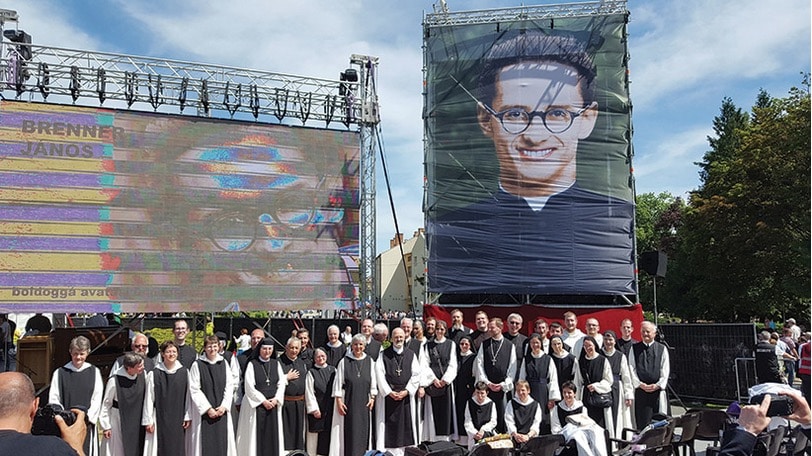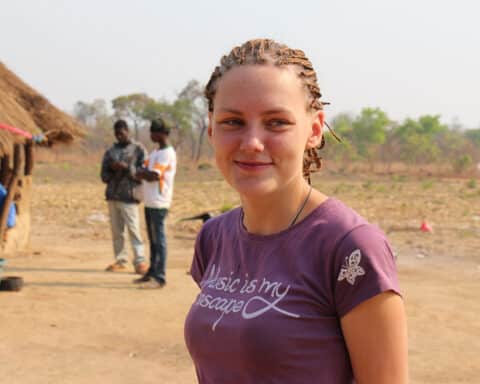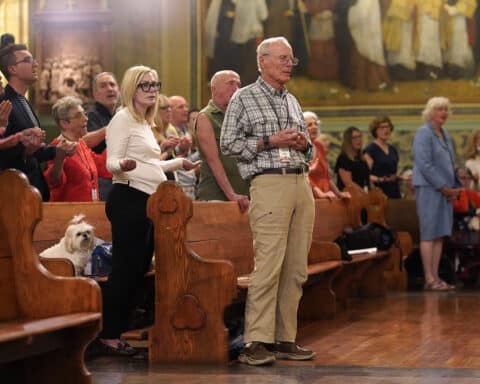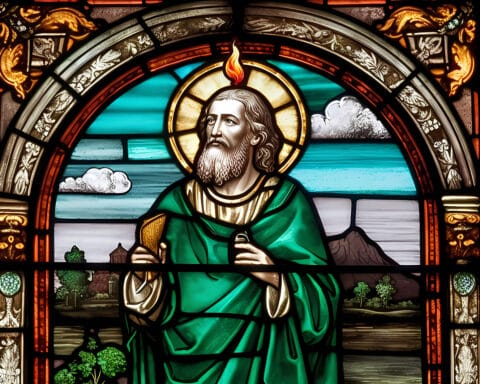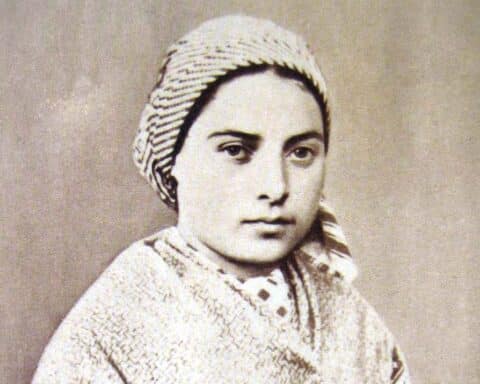Father John Brenner (1931-57), a Hungarian Cistercian priest and martyr, was beatified May 1. Living in communist Hungary, Father Brenner was called to give last rites to a dying man, but it turned out the request was a ruse and instead he was attacked and murdered. His cause for canonization was allowed to begin in 1990 after the fall of communism in Hungary.
Hungarian Cistercian Father Denis Farkasfalvy, 81, abbot emeritus of the Cistercian Abbey of Our Lady of Dallas in Irving, Texas (cistercian.org/abbey/), met Blessed John on three different occasions while living in his native Hungary and since has made an extensive study of his life. He has worked to promote the martyr’s story both to younger religious in his community as well as to laypeople.
He spoke with Our Sunday Visitor about the imprint left by the beatified martyr’s life.
Our Sunday Visitor: How did you come to meet Blessed John Brenner?
Father Denis Farkasfalvy: Blessed John was six years older than me, but I had an older brother who was with him in religious life. On one occasion, for example, I recall opening the door to our house when Blessed John rang the bell. He had come over for a gathering. Once he was inside, though, I’m sure he paid little attention to me!
OSV: What qualities or virtues do you think Blessed John had?
Father Farkasfalvy: He had a deep faith and a dedication to the priesthood. Most impressive to me, however, was his magnetic personality. He was a joyful man, and his happiness was felt by those he met. People would stop him on the street just to speak with him.
He was also good with youth. He was an athlete and would play soccer with the boys. It gave him a chance to hold religion classes, too, so he could teach them the Faith. He’d do it in a way that was fascinating and emanated joy. He really was the ideal priest.
But his popularity irked the government and would cost Blessed John his life.
OSV: What do you remember about Blessed John’s murder?
Father Farkasfalvy: It was 1957, and I was studying in Rome. We knew Hungarians were being imprisoned for their beliefs, with some being executed for their participation in the 1956 Hungarian revolution. But we were still astonished that a young priest was brutally murdered — stabbed 32 times and stomped with boots — rather than arrested and put on trial.
The authorities did a poor job hiding the fact that he was murdered, and it became known within a few weeks. The regime forbade the mention of his name, even going to the seminary to remove his photographs and take his name off plaques. They did these asinine things to make him disappear.
But his village started a cult of his martyrdom. People made pilgrimages to the site of his murder. They collected money and built a church there. The local population kept his memory alive.
I myself have been active in promoting Blessed John’s story. I wrote an article for a Hungarian journal and have spread the word within our order and school. I was able to persuade both our abbot and abbot general to go to his beatification.
OSV: Your monastery, Our Lady of Dallas, continues the work of Blessed John and the Hungarian Cistercians in the United States.
Father Farkasfalvy: Yes. We’re a small monastery in Texas [27 members]. We were started by Hungarian Cistercians in 1958. I came in 1962. We have our own school next door to the monastery, which has 350 boys grades 5-12. We give the boys a classical European education, adopted to U.S. expectations and needs. Fifteen of our priests teach at the school. Some of our priests are also employed to teach at the University of Dallas.
When I came as a refugee from Hungary, I had a doctorate in theology. I had hoped to teach theology for the University of Dallas. My superior, however, wanted me to get a degree in math and teach high school students. He wanted me to be competent in other disciplines besides theology. I have taught math most of my life; I also became headmaster of the school for 12 years.
In 1988, I became abbot of the monastery and served for 24 years. I’ve had multiple illnesses since then, and I use a walker, but I still teach theology at the University of Dallas and to our novices.
OSV: What memories do you have of growing up in Hungary?
Father Farkasfalvy: I grew up during war, which is the worst time to grow up. My hometown is Székesfehérvár, about 50 miles outside of Budapest. It was bombed to little pieces.
My parents were wealthy people and prominent in the community. But, they lost nearly everything during the war. And, when the Soviet regime came, what little we had left was taken away. Between the ages of 12 and 20, I experienced real poverty. I didn’t realize it at the time, because everyone else was in the same situation.
The Soviets persecuted my parents for political and religious reasons. So, we moved to Budapest to try and disappear into the crowd. I became acquainted with religious orders, and the more religion was persecuted by the communists, the more I was attracted to religious life.
I entered the Cistercian monastery in 1954, but soon after it was suppressed. I made my novitiate in secret, as it was illegal to be a novice. Had I been discovered, I could have been arrested. After I left Hungary for Rome, my novice master and many others in my order went to prison.
In 1956, during the Hungarian revolution, my superiors suggested I leave for Rome. The plan was to return in five to 10 years, when the regime had collapsed. But that didn’t happen for another 34 years.
When I finished my studies in Rome, my superiors told me to go to Texas. It was difficult being dislocated, but eventually I was happy working as a math teacher.
OSV: How did you hide from the authorities when you lived in communist Hungary?
Father Farkasfalvy: The idea was to have an identity, a legal occupation, as a layperson. I was a student in law school. I wanted to study French, but in the Hungarian system at the time it didn’t matter what you wanted to study. I was given the choice of going to law school or into the military. I chose law school. I found studying law easy, and it gave me the opportunity to secretly get the training and instruction I needed for religious life.
OSV: How has the situation of the Church improved in Hungary today?
Father Farkasfalvy: The Church today enjoys unhindered freedom, but is very poor and supported by the government. The prime minister, Viktor Orbán, is a Protestant, but [he] is on the side of the Church’s efforts to evangelize. The Church in Hungary has had a whole generation that has grown up without the Faith, and it will take decades for things to be restored. We’ve already seen the Church have a short period of blossoming, however.
OSV: Our Lady of Dallas, your community in Texas, has done well for vocations at a time when many other communities have not. How have you been successful?
Father Farkasfalvy: During my first 12 years as abbot, vocations were a struggle. In 2002, however, we started welcoming novices of good quality. They were young and enthusiastic, with a deep faith. The years following, they streamed into the monastery; 17 have now been ordained priests.
I think it took a dying out of our older Hungarians which paved the way for their replacement by Americans. There are only three of us Hungarians left, and we are old and not participating in any significant work of the monastery. The average age of our community today is 35.
OSV: Do you have any other thoughts on Blessed John?
Father Farkasfalvy: This is the first time in the history of our congregation that the Holy Father has recognized one of our members. We’re 800 years old, and we hadn’t previously had anyone elevated to blessed or canonized. It is astonishing. I want my brothers here in the monastery, as well as all Catholics, to understand the gift of God that they were given in the life of Blessed John Brenner.
Jim Graves writes from California.

